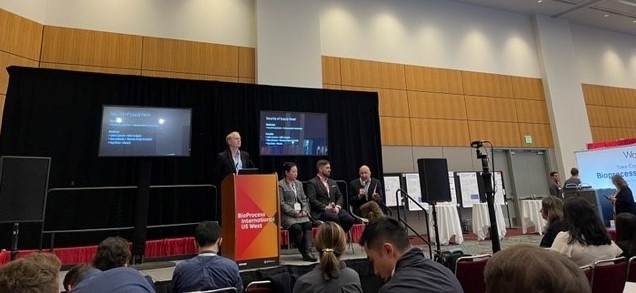Content Spotlight
Podcast: MilliporeSigma says education vital to creating unbreakable chain for sustainability
MilliporeSigma discusses the importance of people, education, and the benefits of embracing discomfort to bolster sustainability efforts.

Despite COVID-19 highlighting supply chain issues, biomanufacturers are still using single sources, say experts at BPI West.
In the early stages of the COVID-19 pandemic, single-use bioprocess systems and materials were highlighted as necessary tools in the development and commercial manufacture of potential vaccines and therapies.
Said materials and equipment were already in high demand throughout the sector, but the pandemic placed further pressure on raw material and bioprocess equipment supply, with lead times for some single-use components equating to a year or more.

BPI West 2023, panel at BPI Theatre. Image c/o Millie Nelson
The panelists collectively discussed how some companies are still using a single source for their supply, which carries great danger.
Dan Johnson, senior director, Digital Supply Chain Enablement at Thermo Fisher Scientific, said “we have come out of a situation where demand exceeded supply and now we need to learn from the past and put in solutions so that the supply chain becomes more rigid.”
However, he added: “the industry has not moved fast enough, the problem of single source [use] is still there.”
Cannon agreed and said “this problem has been there for 30 years. Additionally, there are companies that are buying from the same suppliers.” Therefore, if that specific supplier was to experience any challenges, a number of companies’ supply chain security would then be affected.
Moreover, Cannon said a “bunch of players have moved into the single-use space and lots of companies have geographically moved or expanded” because of the pandemic. This means regional players are now considered as “global players” after moving to the US and this places further constraints onto the supply chain.
While selecting a single source approach might make things easier, Shen told the audience it is just that “until it is not.”
To deal with the supply chain challenges, which are still being faced, Johnson told his fellow panelists and audience “the process of supply chain risk management hasn’t really changed for us, but the focus area has.”
Johnson said while Thermo Fisher’s nature is to produce customized products, it is focusing on “stocking critical standard components where possible as it provides our customers with confidence” and protects the supply chain. Moreover, he briefly mentioned that we “don’t need to throw people at the problem” but we can look to digitalize the supply chain to ease challenges.
Cannon said it is important for companies to have “some inventory as you cannot run the facility fully just-in-time (JIT).” If you are to have inventory, “it gives you some time” and it builds on the lessons of COVID-19 where the industry “could not act fast enough.”
The US Food and Drug Administration (FDA) issued a draft guide to tackle supply chain issues in May 2022 and said implementing risk management principles should be applied throughout the drug supply chain to help mitigate the risk of shortages.
You May Also Like